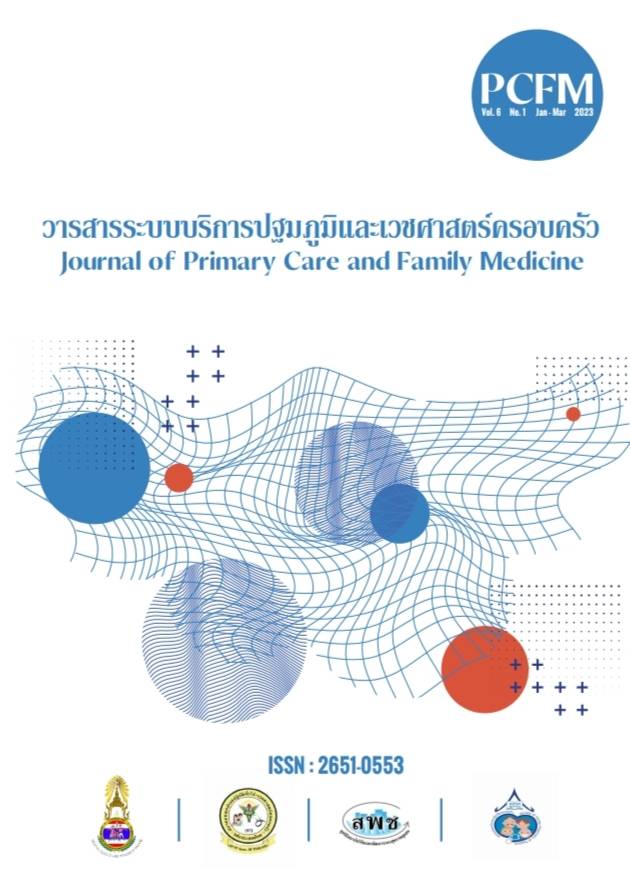ตรวจสอบความไวและความจำเพาะของแบบประเมินปัญหาที่เกี่ยวข้องกับโรคเบาหวานฉบับภาษาไทยและแบบวัดความทุกข์ยากจากการเจ็บป่วยด้วยโรคเบาหวานฉบับภาษาไทยในเขตเมือง
Main Article Content
บทคัดย่อ
ที่มาและวัตถุประสงค์: กลุ่มอาการตึงเครียดทางอารมณ์ในผู้ป่วยเบาหวานส่งผลเสียต่อสุขภาพหลายประการ จึงมีการพัฒนาแบบทดสอบเพื่อคัดกรองขึ้น แบบประเมินปัญหาที่เกี่ยวข้องกับโรคเบาหวาน (The Problem Areas in Diabetes Scale, PAID-5 และแบบวัดความทุกข์ยากจากการเจ็บป่วยด้วยโรคเบาหวาน (Diabetes distress score, DDS) ถูกนำมาแปลเป็นภาษาไทยและได้รับความนิยมในการนำมาใช้ แต่ยังมีข้อมูลจำกัดในเรื่องความไวและความจำเพาะของแบบทดสอบดังกล่าว การศึกษาวิจัยนี้จึงจัดทำเพื่อประเมินความไวและความจำเพาะของแบบทดสอบ PAID-5 และ DDS ฉบับภาษาไทย
รูปแบบวิจัย: การศึกษาภาคตัดขวางเชิงพรรณนา
วิธีการ: อาสาสมัครจำนวน 100 คนที่เข้ารับบริการที่ห้องตรวจภาควิชาเวชศาสตร์เขตเมืองและหน่วยปฐมภูมิเขตเมือง โรงพยาบาลวชิรพยาบาล ตั้งแต่ 1 เมษายน ถึง 31 สิงหาคม 2565 ทำแบบสอบถามข้อมูลทั่วไป แบบบทดสอบ PAID-5 และ DDS ฉบับภาษาไทย โดยใช้แบบสอบถาม Hospital Anxiety and Depression Scale ฉบับภาษาไทยในการเปรียบเทียบ
ผลการศึกษา: แบบทดสอบ PAID-5 ฉบับภาษาไทยมีค่าความไว ร้อยละ 40 ค่าความจำเพาะ ร้อยละ 86.3 และแบบทดสอบ DDS ฉบับภาษาไทยมีค่าความไว ร้อยละ 40 ค่าความจำเพาะ ร้อยละ 93.7 เปรียบเทียบค่าความไว ความจำเพาะไม่ต่างกันอย่างมีนัยสำคัญทางสถิติ
สรุป: แบบทดสอบ PAID-5 และ DDS ฉบับภาษาไทยมีค่าความไวต่ำ ไม่เหมาะกับการนำมาใช้คัดกรอง ทั้งนี้อาจนำมาประเมินเพิ่มเติมในผู้ป่วยที่สงสัยว่ามีอาการตึงเครียดทางอารมณ์ในผู้ป่วยเบาหวานเนื่องจากมีความจำเพาะสูง
Article Details

อนุญาตภายใต้เงื่อนไข Creative Commons Attribution-NonCommercial-NoDerivatives 4.0 International License.
เนื้อหาและข้อมูลในบทความที่ลงตีพิมพ์ในวารสาร PCFM ถือเป็นข้อคิดเห็นและความรับผิดชอบของผู้เขียนบทความโดยตรง ซึ่งกองบรรณาธิการวารสารไม่จำเป็นต้องเห็นด้วยหรือร่วมรับผิดชอบใด ๆ
บทความ ข้อมูล เนื้อหา รูปภาพ ฯลฯ ที่ได้รับการตีพิมพ์ลงในวารสาร PCFM ถือเป็นลิขสิทธิ์ของวารสาร PCFM หากบุคคลหรือหน่วยงานใดต้องการนำทั้งหมดหรือส่วนหนึ่งส่วนใดไปเผยแพร่ต่อหรือเพื่อกระทำการใด ๆ จะต้องได้รับอนุญาตเป็นลายลักษณ์อักษรจากวารสาร PCFM ก่อนเท่านั้น
เอกสารอ้างอิง
International Diabetes Federation. IDF Diabetes Atlas. 9th edn. Brussels; 2019.
วิชัย เอกพลการ, หทัยชนก พรรคเจริญ, กนิษฐา ไทยกล้า. รายงานการสำรวจสุขภาพประชาชนไทยโดยการตรวจร่างกาย ครั้งที่ 5 พ.ศ.2557 [Internet]. 2557 [เข้าถึงเมื่อ 27 ก.ค. 2564]. เข้าถึงได้จาก: http://www.thaincd.com/document/file/info/non-communicable-disease/การสำรวจสุขภาพประชาชนไทย_ครั้งที่_5_NHES_5.pdf.
กองโรคไม่ติดต่อ กรมควบคุมโรค กระทรวงสาธารณสุข. จำนวนและอัตราป่วย/ตายปี 2559-2562 ต่อประชากรแสนคน (รวมทุกการวินิจฉัยโรค) จำแนกรายจังหวัด เขตบริการสุขภาพและภาพรวมประเทศ (รวมกรุงเทพมหานคร) [Internet]. 2562 [เข้าถึงเมื่อ 27 ก.ค. 2564]. เข้าถึงได้จาก http://www.thaincd.com/2016/mission/documents-detail.php?id=13893&tid=32&gid=1-020
สุรเกียรติ อาชานานุภาพ, วัลลา ตันตโยทัย, สุพัตรา ศรีวณิชชากร, ณภากุล โรจนสุภัค, ทัศนีย์ ญาณะ, บรรณาธิการ. คู่มือหน่วยบริการปฐมภูมิ:การจัดการเบาหวานแบบบูรณาการ. สถาบันวิจัยและพัฒนาสุขภาพชุมชน;2552.
Egede LE, Hernández-Tejada MA. Effect of comorbid depression on quality of life in adults with Type 2 diabetes. Expert Rev Pharmacoeconomics Outcomes Res. 2013;13(1):83–91.
Harris MD. Psychosocial aspects of diabetes with an emphasis on depression. Curr Diab Rep. 2003;3(1):49–55.
Maraldi C, Volpato S, Penninx BW, Yaffe K, Simonsick EM, Strotmeyer ES, et al. Diabetes Mellitus, Glycemic Control, and Incident Depressive Symptoms Among 70- to 79-Year-Old Persons. Arch Intern Med. 2007;167(11):1137.
สมพร รุ่งเรืองกิจ, ยุพา ถาวรพิทักษ์, วราลักษณ์ กิตติวัฒน์ไพศาล. ความชุกและปัจจัยทำนายภาวะซึมเศร้าในผู้ป่วยเบาหวานชนิดที่ 2. วารสารสมาคมจิตแพทย์แห่งประเทศไทย. 2014;59(3):287–298.
Cheng LJ, Wang W, Lim ST, Wu VX. Factors associated with glycaemic control in patients with diabetes mellitus: A systematic literature review. J Clin Nurs. 2019;28(9–10):1433–1450.
Lin EH, Katon W, Von Korff M, Rutter C, Simon GE, Oliver M, et al. Relationship of Depression and Diabetes Self-Care, Medication Adherence, and Preventive Care. Diabetes Care. 2004;27:2154–2160.
Lustman PJ, Anderson RJ, Freedland KE, de Groot M, Carney RM, Clouse RE. Depression and poor glycemic control: a meta-analytic review of the literature. Diabetes Care. 2000;23(7):934-942.
Dunn SM, Smartt HH, Beeney LJ, Turtle JR. Measurement of emotional adjustment in diabetic patients: validity and reliability of ATT39. Diabetes Care. 1986;9(5):480–489.
Polonsky WH, Anderson BJ, Lohrer PA, Welch G, Jacobson AM, Aponte JE, Schwartz CE. Assessment of Diabetes-Related Distress. Diabetes Care. 1995;18(6):754–760.
Herschbach P, Duran G, Waadt S, Zettler A, C Amm, Marten-Mittag B. Psychometric properties of the Questionnaire on Stress in Patients with Diabetes--Revised (QSD-R). Health Psychol. 1997;16(2):171-174.
Gross CC, Scain SF, Scheffel R, Gross JL, Hutz CS. Brazilian version of the Problem Areas in Diabetes Scale (B-PAID): Validation and identification of individuals at high risk for emotional distress. Diabetes Res Clin Pract. 2007;76(3):455–459.
Huang MF, Courtney M, Edwards H, McDowell JAN. Validation of the Chinese version of the Problem Areas in Diabetes (PAID-C) scale. Diabetes Care. 2010;33(1):38–40.
Jannoo Z, Yap BW, Khan NM, Farcomeni A. Assessing Diabetes Distress Among Type 2 Diabetes Mellitus in Malaysia Using the Problem Areas in Diabetes Scale. Value Heal Reg Issues. 2019;18:159–164.
Beléndez M, Hernández-Mijares A, Marco J, Domínguez JR, Pomares FJ. Validation of the Spanish version of the Problem Areas in Diabetes (PAID-SP) Scale. Diabetes Res Clin Pract. 2014;106(3):e93–e95.
Polonsky WH, Fisher L, Earles J, Dudl RJ, Lees J, Mullan J, et al. Assessing psychosocial distress in diabetes: development of the diabetes distress scale. Diabetes Care. 2005;28(3):626–631.
Thanakwang K, Thinganjana W, Konggumnerd R. Psychometric properties of the Thai version of the Diabetes Distress Scale in diabetic seniors. Clin Interv Aging. 2014;9:1353-1361.
McGuire BE, Morrison TG, Hermanns N, Skovlund S, Eldrup E, Gagliardino J, et al. Short-form measures of diabetes-related emotional distress: The Problem Areas in Diabetes Scale (PAID)-5 and PAID-1. Diabetologia. 2010;53(1):66–69.
Perrin NE, Davies MJ, Robertson N, Snoek FJ, Khunti K. The prevalence of diabetes-specific emotional distress in people with Type 2 diabetes: a systematic review and meta-analysis. Diabetic Medicine. 2017;34(11):1508–1520.
ธนา นิลชัยโกวิทย์, มาโนช หล่อตระกูล, อุมาภรณ์ ไพศาลสุทธิเดช. การพัฒนาแบบสอบถาม Hospital Anxiety and Depression Scale ฉบับภาษาไทยในผู้ป่วยโรคมะเร็ง. วารสารสมาคมจิตแพทย์แห่งประเทศไทย. 1996;41(1):18-30.
Topp CW, Østergaard SD, Søndergaard S, Bech P. The WHO-5 Well-Being Index: A Systematic Review of the Literature. Psychotherapy and Psychosomatics. 2015;84(3):167–176.


